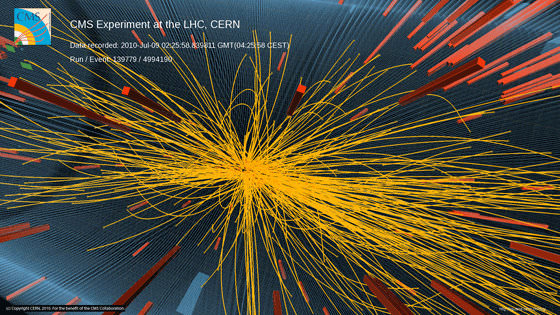[/caption]
Scientists at the Large Hadron Collider reported today they apparently have discovered a previously unobserved phenomenon in proton-proton collisions. One of the detectors shows that the colliding particles appear to be intimately linked in a way not seen before in proton collisions. The correlations were observed between particles produced in 7 TeV collisions. “The new feature has appeared in our analysis around the middle of July,” physicist Guido Tonelli told fellow CERN scientists at a seminar to present the findings from the collider’s CMS (Compact Muon Solenoid) detector.
The scientists said the effect is subtle and they have performed several detailed crosschecks and studies to ensure that it is real. It bears some similarity to effects seen in the collisions of nuclei at the RHIC facility located at the US Brookhaven National Laboratory, which have been interpreted as being possibly due to the creation of hot dense matter formed in the collisions.
CMS studies the collisions by measuring angular correlations between the particles as they fly away from the point of impact.
The scientists stressed that there are several potential explanations to be considered and the they presented their news to the physics community at CERN today in hopes of “fostering a broader discussion on the subject.”
“Now we need more data to analyze fully what’s going on, and to take our first steps into the vast landscape of new physics we hope the LHC will open up,” said Tonelli.
Proton running at the Large Hadron Collider is scheduled to continue until the end of October, during which time CMS will accumulate much more data to analyze. After that, and for the remainder of 2010, the LHC will collide lead nuclei.
Source: CERN


From the introductory presentation:
From the presentation:
And they redid the analysis using several extraction codes.
Time to crack open the quark-gluon plasma string theory calculations again? Anyway, way to cross the streams, LHC!
It turns out there is a bit of a buzz going on today. There appears to be new correlations with p p-bar scattering. The full experimental report is at
http://cms.web.cern.ch/cms/News/2010/QCD-10-002/QCD-10-002.pdf
To be honest I am not sure what this means and I have not read this paper yet.
LC
Any word yet on the Higgs though?
This does not involve the Higgs, but appears to be a quark-gluon plasma that occurs on a low energy scale not expected. To be honest I find this to be good news, for it suggests that QCD~AdS physics may be found here. I will report here what I read up, which may take a day or two for me to assimilate.
LC
Nice! Beautiful timing – I’ve just taken the Physics of the Standard Model, High Energy Physics and a few related courses at uni. A perfect time to be pushing forward in this area as far as I’m concerned, because now I at least understand what the hell they’re talking about!
That’s a very me-centric way of looking at it all, but my hunch is that they are going to discover at the LHC that contrary to currently accepted theory, the universe does indeed have a center and that center is me.
I tried the link above to Cern pdf but it won’t open. Is there another link to it?
The link works fine. There is a general news link to the CMS
http://cms.web.cern.ch/cms/News/2010/QCD-10-002/
which also works.
LC
that center of the universe is yourself, it is not “me” ! Essentially nobody knows more about the universe then YOU do. In fact, nobody can even agree to what the universe is, nor can anyone describe it. the LHC was built to study the big bang baby love universe model, but to me the proton-proton collision photo looks timelessly fractal. It could be an entire supernova, quasar-galaxy, or mini big-bang black hole collision taking place throwing out dust debris. If we could travel at light speed in a tiny ship alongside the proton-proton collision, we might be able to observe self-similarities with familiar cosmic structures, like those resembling exploding supernovas or binaries colliding, merging black hole galaxies, and superclusters in the process of forming great walls, etc.